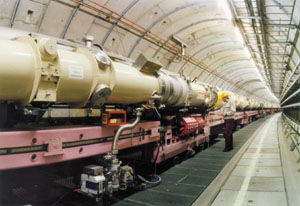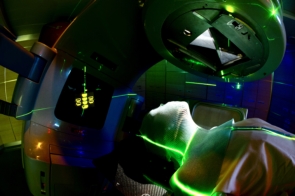The unique HERA electron-proton collider at DESY, Hamburg, achieved record performance in 2000 before being shut down for nine months of “lumi upgrade”.

For the machine crew at the DESY laboratory, Hamburg, the result of the 2000 run of the HERA electron-proton collider is something to be proud of. As the ever-rising curves of the accelerator’s luminosity show, the performance of DESY’s 6.3 km flagship accelerator has been increasing steadily ever since it was commissioned in 1992 – an evolution that reached its peak with this year’s particle physics run.
A total of only 18 days were spent on maintenance work and machine studies since the beginning of the run on 17 January. The rest of the time, HERA was operated around the clock with the same efficiency as in 1999, with almost all the accelerator parameters achieving or exceeding their original design values.
In particular, HERA reached the peak value of 67 pb-1 integrated luminosity (luminosity is a measure of the “impact rate” of the electrons and protons circulating inside the storage ring facility and the particle collisions delivered to the experiments), thereby nearly doubling its performance when compared to the design specification of 35 pb-1.
From 4 September, HERA is enjoying a well-deserved nine-month break: activities in the tunnel are buzzing to get the accelerator back with a luminous 150 pb-1 per year next summer.
Getting the machine to reach its planned luminosity target by 1997 – five years after commissioning – had already required a range of improvements. In particular, HERA and its preaccelerator PETRA were fitted with new control systems, which considerably improved the quality of the proton beam.
Electron compatibility
However, a few nagging problems persisted. Operating HERA with electrons proved especially problematic. At just two hours, the lifetime of the particle beam was unexpectedly short, probably due to positively ionized impurities disturbing the beam. To get round this problem, it was decided to switch to positron operation in 1994. In general, the lifetime of the beam has proved to be much better when running with positrons (by a factor of up to two). The energy of the HERA electrons (or positrons) is 27.5 GeV.

The problem of making HERA “electron compatible” was reduced during the 1997/1998 winter shutdown by changing the vacuum pumps of the electron storage ring. The original ion getter pumps were replaced by passive non-evaporating getter (NEG) pumps – adsorption pumps without high voltage that do not accelerate dust particles into the beam vacuum. At the same time, additional measures were carried out to improve the reliability and efficiency of the machine: for example, an additional radiofrequency power reserve improved the operational stability; complete reorganization of HERA’s control system extended its functionality and improved operating efficiency; the radiofrequency couplers for the superconducting cavities of the electron ring were reconstructed; and the old, often reused main power supply of the superconducting ring was replaced. These extensive modifications paid off. HERA’s particle collision rate with electrons was just as high in 1999 as the rate obtained with positrons two years before.
Higher energy protons
The increase of the proton energy from 820 to 920 GeV was carried out without problems as well, despite its pushing the superconducting magnet system closer to its limits. What’s more, HERA provided the fixed target experiment HERMES with a stable supply of longitudinally spin-polarized electrons, with polarization of the beam routinely lying between 50 and 60% (and peak values reaching 65%).
This year also saw the full integration into operations of the fourth HERA experiment HERA-B, a fixed target experiment using the proton beam of the accelerator. HERA’s increase in efficiency was thus achieved, although both particle beams are used in parallel by the collider experiments H1 and ZEUS and two fixed-target experiments.
More luminous
HERA’s exceptional performance this year was the crowning touch before extensive work to improve luminosity began in September. The goal is to increase the luminosity four- to five-fold in order to provide experimental access to extremely rare processes.
To achieve this, it will be necessary to reduce the cross-sections of the particle beams at the north and south interaction points to a third of their current area, that is from 21 mm2 to 7 mm2. This is quite a challenge, as it also entails a complete rearrangement of the interaction zones.
In particular, it will be necessary to move the low-beta quadrupoles closer to the collision points. The first low beta quadrupoles will be fitted right into the H1 and ZEUS detectors. These quadrupoles also provide the fields which merge and separate the protons and electrons before and after the collisions respectively.
The powerful synchrotron radiation due to the magnetic beam separation will be absorbed downstream, far away from the detectors. Several unconventional components had to be designed to handle this synchrotron radiation problem, including extremely small superconducting magnets that will be integrated into the H1 and ZEUS detectors, as well as keyhole-shaped vacuum chambers, which will be built into the machine at the end of 2000.
Thanks to these major improvements, HERA will be in excellent shape to take on the challenges of the new millennium when it restarts with five times its old luminosity in the summer of 2001.





